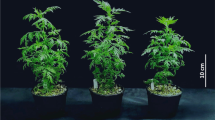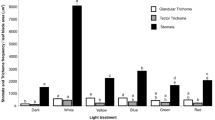Abstract
Artemisia annua L. produces a compound called artemisinin that is a potent anti-malarial compound. However concentration of artemisinin within the plant is typically low (less than 0.8% of dry mass) and currently supply of the drug by the plant does not meet world demand. This investigation was carried out to determine whether high intensity light treatment would increase production of artemisinin in leaves of A. annua. Photoinhibition (14%) was induced in leaves of A. annua when they were subjected to 6 h of high-intensity light [2,000 μmol(photon) m-2 s−1]. Maximum photochemical efficiency of PSII showed a recovery of up to 95% within 24 h of light induced inhibition. During the light treatment, photochemical efficiency of PSII in leaves of the high-intensity light-treated plants was 38% lower than for those from leaves of plants subjected to a low-intensity-light treatment of 100 μmol(photon) m-2 s−1. Nonphotochemical quenching of excess excitation energy was 2.7 times higher for leaves treated with high-intensity light than for those irradiated with low-intensity light. Elevation in oxidative stress in irradiated leaves increased presence of reactive oxygen species (ROS) including singlet oxygen, superoxide anions, and hydrogen peroxide. Importantly, the concentration of artemisinin in leaves was two-fold higher for leaves treated with high-intensity light, as compared to those treated with low-intensity light. These results indicate that A. annua responds to high irradiance through nonphotochemical dissipation of light energy yet is subject to photoinhibitory loss of photosynthetic capacity. It can be concluded that A. annua is capable of rapid recovery from photoinhibition caused by high light intensity. High light intensity also induced oxidative stress characterized by increased concentration of ROS which enhanced the content of artemisinin. Such a light treatment may be useful for the purpose of increasing artemisinin content in A. annua prior to harvest.
Similar content being viewed by others
Abbreviations
- ACT:
-
artemisinin-based combination therapy
- APX:
-
ascorbate peroxidase
- FM:
-
fresh mass
- Fm :
-
maximal fluorescence yield of the dark-adapted state
- Fm′:
-
maximal fluorescence yield of the light-adapted state
- Fs :
-
steady-state fluorescence yield
- Fv :
-
variable fluorescence
- Fv/Fm :
-
maximal quantum yield of PSII photochemistry
- HPLC:
-
high pressure liquid chromatography
- NPQ:
-
nonphotochemical quenching of PSII
- ROS:
-
reactive oxygen species
- qP :
-
photochemical quenching coefficient
- SD:
-
standard deviation
- UV-B:
-
ultraviolet-B
- UV-C:
-
ultraviolet-C
- ΦPSII :
-
quantum efficiency of PSII
- WHO:
-
World Health Organization
References
Abdin M.Z., Israr M., Rehman R.U., Jain S.K.: Artemisinin, a novel antimalarial drug: biochemical and molecular approaches for enhanced production. — Planta Med. 69: 289–299, 2003.
Able A.J., Guest D.I., Sutherland M.W.: Use of a new tetrazolium-based assay to study the production of superoxide radicals by tobacco cell cultures challenged with avirulent zoospores of Phytophthora parasitica var nicotianae. — Plant Physiol. 117: 491–499, 1998.
Aftab T., Khan M.M.A., Idrees M. et al.: Stimulation of crop productivity, photosynthesis and artemisinin production in Artemisia annua L. by triacontanol and gibberellic acid application. — J. Plant Interact. 5: 273–281, 2010a.
Aftab T., Khan M.M.A., Idrees M. et al.: Boron induced oxidative stress, antioxidant defense response and changes in artemisinin content in Artemisia annua L. — J. Agron. Crop Sci. 196: 423–430, 2010b.
Aftab T., Khan M.M.A., Teixeira da Silva J.A. et al.: Role of salicylic acid in promoting salt stress tolerance and enhanced artemisinin production in Artemisia annua L. — J. Plant Growth Regul. 30: 425–435, 2011
Apel K., Hirt H.: Reactive oxygen species: metabolism, oxidative stress, and signal transduction. — Annu. Rev. Plant Biol. 55: 373–399, 2004.
Asada K.: The water-water cycle in chloroplasts: scavenging of active oxygen species and dissipation of excess photons. — Annu. Rev. Plant. Biol. 50: 601–639, 1999.
Asada K., Takahashi M.: Production and scavenging of active oxygen in photosynthesis. — In: Kyle D.J., Osmond C.B., Arntzen C.J. (ed.): Photoinhibition (Topics in Photosynthesis, Vol. 9) Pp. 227–287. Elsevier, Amsterdam 1987.
Asada K.: Production and scavenging of reactive oxygen species in chloroplasts and their functions. — Plant Physiol. 141: 391–396, 2006.
Banyai W., Mii M., Supaibulwatana K.: Enhancement of artemisinin content and biomass in Artemisia annua by exogenous GA3 treatment. — Plant Growth Regul. 63: 45–54, 2011.
Brisibe E.A., Chukwurah P.N.: Production of artemisinin in planta and in microbial systems need not be mutually exclusive: — In: Aftab T., Ferreira J.F.S., Khan M.M.A., Naeem M. (ed.): Artemisia annua — Pharmacology and Biotechnology. Pp. 269–292. Springer, Berlin 2014.
Charles D.J, Simon J.E., Shock C.C. et al.: Effect of water stress and post-harvest handling on artemisinin content in the leaves of Artemisia annua L. — In: Janick J., Simon J.E. (ed.): New Crops. Pp. 628–631. Wiley, New York 1993.
Davies M.J., Atkinson C.J., Burns C. et al.: Enhancement of artemisinin concentration and yield in response to optimization of nitrogen and potassium supply to Artemisia annua. — Ann. Bot-London 104: 315–323, 2009.
Delabays N. Simonnet X. Gaudin M.: The genetics of Artemisinin content in Artemisia annua L. and the breeding of high yielding cultivars. — Curr. Med. Chem. 8: 1798–1801, 2001.
Efferth T., Romero M.R., Wolf D.G. et al.: The antiviral activities of Artemisinin and Artesunate. — Clin. Infect Dis. 47: 804–811, 2008.
Feng L.-L., Yang R.-Y., Yang X.-Q. et al.: Synergistic rechanneling of mevalonate pathway for enhanced artemisinin production in transgenic Artemisia annua. — Plant Sci. 177: 57–67, 2009.
Ferreira J.F.S.: Nutrient deficiency in the production of artemisinin, dihydroartemisinic acid, and artemisinic acid in Artemisia annua L. — J. Agr. Food Chem. 55:1686–1694, 2007.
Ferreira J.F.S., Simon J.E., Janick J.: Developmental studies of Artemisia annua: flowering and artemisinin production under greenhouse and field conditions. — Planta Med. 61: 167–170, 1995.
Ferreira J.F.S., Luthria D.L.: Drying affects artemisinin, dihydroartemisinic acid, artemisinic acid, and the antioxidant capacity of Artemisia annua L. leaves. — J. Agr. Food Chem. 58: 1691–1698, 2010.
Ferreira J.F.S., Luthria D.L., Sasaki T., Heyerick A.: Flavonoids from Artemisia annua L. as antioxidants and their potential synergism with artemisinin against malaria and cancer. — Molecules 15: 3135–3170, 2010.
Genty B., Briantais J.-M., Baker N.R.: The relationship between the quantum yield of photosynthetic electron transport and quenching of chlorophyll fluorescence. — Biochim. Biophys. Acta. 990: 87–92, 1989.
Graham I.A., Besser K., Blumer S. et al.: The genetic map of Artemisia annua L. identifies loci affecting yield of the antimalarial drug artemisinin. — Science 327: 328–331, 2010.
Guo X.-X., Yan X.-Q., Yang R.-Y., Zeng Q.-P.: Salicylic acid and methyl jasmonate but not rose bengal enhance artemisinin production through invoking burst of endogenous singlet oxygen. — Plant Sci. 178: 390–397, 2010.
Han J.-L., Liu B.-Y., Ye H.-C. et al.: Effects of overexpression of the endogenous farnesyl diphosphate synthase on the artemisinin content in Artemisia annua L. — J. Integr. Plant Biol. 48: 482–487, 2006.
Horton P., Ruban A.V., Walters R.G.: Regulation of light, harvesting in green plants. — Annu. Rev. Plant Phys. 47: 655–684, 1996.
Ivanescu B., Corciova A.: Artemisinin in cancer therapy. — In: Aftab T., Ferreira J.F.S., Khan M.M.A., Naeem M. (ed.): Artemisia annua — Pharmacology and Biotechnology. Pp. 205–227. Springer, Berlin 2014.
Kok B.: On the inhibition of photosynthesis by intense light. — Biochim. Biophys. Acta 21: 234–244, 1956.
Krishna S., Bustamante L., Haynes R.K., Staines H.M.: Artemisinins: their growing importance in medicine. — Trends Pharmacol. Sci. 29: 520–527, 2008.
Kyle D.J.: The biochemical basis for photoinhibition of photosystem II. — In: Kyle D.J., Osmond C.B., Arntzen C.J. (ed.): Photoinhibition. Pp. 197–226. Elsevier, Amsterdam 1987.
Lei C., Ma D., Pu G. et al.: Foliar application of chitosan activates artemisinin biosynthesis in Artemisia annua L. — Ind. Crop Prod. 33: 176–182, 2011.
Li X., Zhao M., Guo L., Huang L.: Effect of cadmium on photosynthetic pigments, lipid peroxidation, antioxidants, and artemisinin in hydroponically grown Artemisia annua. — J. Environ. Sci. 24: 1511–1518, 2012.
Liu D., Zhang L., Li C. et al.: Effect of wounding on gene expression involved in artemisinin biosynthesis and artemisinin production in Artemisia annua. — Russ. J. Plant Physl+ 57: 882–886, 2010.
Logan B.A.: Reactive oxygen species and photosynthesis. — In: Smirnoff N. (ed.): Antioxidants and Reactive Oxygen Species in Plants. Pp. 250–267. Blackwell, Oxford 2005.
Mannan A., Liu C., Arsenault P.R. et al.: DMSO triggers the generation of ROS leading to an increase in artemisinin and dihydroartemisinic acid in Artemisia annua shoot cultures. — Plant Cell Rep. 29: 143–152, 2010.
Marchese J.A., Ferreira J.F.S., Rehder V.L.G., Rodrigues O.: Water deficit effect on the accumulation of biomass and artemisinin in annual wormwood (Artemisia annua L., Asteraceae). — Braz. J. Plant Physiol. 22: 1–9, 2010.
Mishra A., Choudhuri M.A.: Effects of salicylic acid on heavy metal-induced membrane deterioration mediated by lipoxygenase in rice. — Biol. Plantarum 42: 409–415, 1999.
Mukherjee S.P., Choudhuri M.A. Implications of water stressinduced changes in the levels of endogenous ascorbic acid and hydrogen peroxide in Vigna seedlings. — Physiol. Plantarum 58: 166–170, 1983.
Müller P., Li X.-P., Niyogi K.N.: Non-Photochemical Quenching. A response to excess light energy. — Plant Physiol. 125: 1558–1566, 2001.
Ohad I., Keren N., Zer H. et al.: Light induced degradation of the photochemical reaction center II D1 protein in-vivo: an integrative approach. — In: Baker N.R., Bowyer J.R. (ed.): Photoinhibition of Photosynthesis From Molecular Mechanisms to the Field. Pp. 161–171. Bios Scientific, Oxford 1993.
Paddon C. J., Westfall P. J., Pitera D. J. et al.: High-level semisynthetic production of the potent antimalarial artemisinin. — Nature 496: 528–532, 2013.
Pandey A.V., Tekwani B.L., Singh R.L., Chauhan V.S.: Artemisinin, an endoperoxide antimalarial, disrupts the hemoglobin catabolism and heme detoxification systems in malarial parasite. — J. Biol. Chem. 274: 19383–19388, 1999.
Pu G.-B., Ma D.-M., Chen J.-L. et al.: Salicylic acid activates artemisinin biosynthesis in Artemisia annua L. — Plant Cell Rep. 28: 1127–1135, 2009.
Qureshi M.I., Israr M., Abdin M.Z., Iqbal M.: Responses of Artemisia annua L. to lead and salt-induced oxidative stress. — Environ. Exp. Bot. 53: 185–193, 2005.
Rai R., Meena R.P., Smita S.S. et al.: UV-B and UV-C pretreatments induce physiological changes and artemisinin biosynthesis in Artemisia annua L. — An antimalarial plant. — J. Photoch. Photbio. B 105: 216–225, 2011.
Sen R., Ganguly S., Saha P., Chatterjee M.: Efficacy of artemisinin in experimental visceral leishmaniasis. — Int. J. Antimicrob. Ag. 36: 43–49, 2010.
Triantaphylidès C., Krischke M., Hoeberichts F.A. et al.: Singlet oxygen is the major reactive oxygen species involved in photooxidative damage to plants. — Plant Physiol. 148: 960–968, 2008.
van Agtmael M.A., Eggelte T.A., van Boxtel C.J.: Artemisinin drugs in the treatment of malaria: from medicinal herb to registered medication. — Trends Pharmacol. Sci. 20: 199–205, 1999.
Wallaart T.E., van Uden W., Lubberink H.G.M. et al.: Isolation and identification of dihydroartemisinic acid from Artemisia annua and its possible role in the biosynthesis of Artemisinin. — J. Nat. Prod. 62: 430–433, 1999.
Wang M.L., Jiang Y.S., Wei J.Q. et al.: Effects of irradiance on growth, photosynthetic characteristics, and artemisinin content of Artemisia annua L. — Photosynthetica 46: 17–20, 2008.
World Health Organization: WHO monograph on good agricultural and collection practices (GACP) for Artemisia annua L. Pp. 58. WHO, Geneva 2006.
Zeng Q.-P., Zeng X.-M., Yang R.-Y., Yang X.-Q.: Singlet oxygen as a signaling transducer for modulating artemisinin biosynthetic genes in Artemisia annua. — Biol. Plantarum 55: 669–674, 2011.
Author information
Authors and Affiliations
Corresponding author
Rights and permissions
About this article
Cite this article
Poulson, M.E., Thai, T. Effect of high light intensity on photoinhibition, oxyradicals and artemisinin content in Artemisia annua L.. Photosynthetica 53, 403–409 (2015). https://doi.org/10.1007/s11099-015-0130-5
Received:
Accepted:
Published:
Issue Date:
DOI: https://doi.org/10.1007/s11099-015-0130-5




